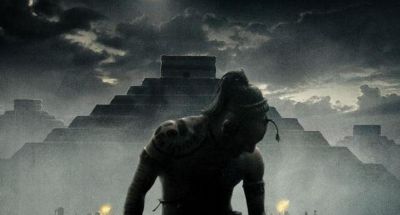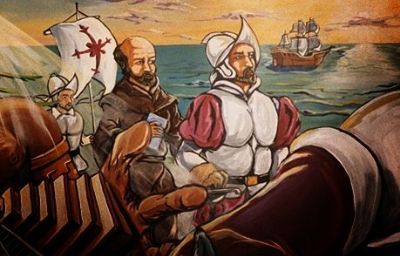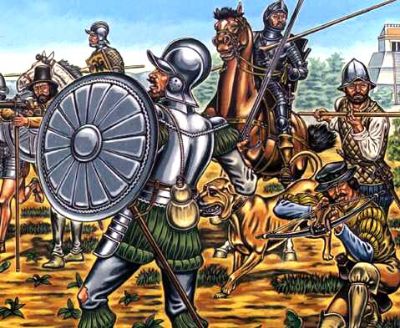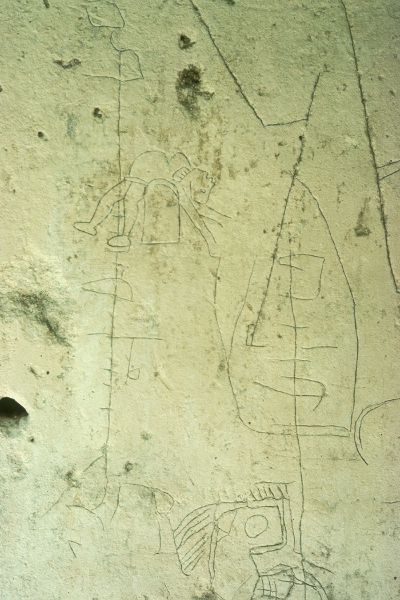
See also:
· Maya Vase Sacrifice Scenes
· Chichen Itza and the Well of Sacrifice
 Beyond Chron Beyond Chron
January 10, 2007
Copyright © 2007 Marc Norton
Mel Gibson's Apocalypto has been ravaged by many critics -- by those out to get Gibson for his recent anti-Semitic tirade at an unlucky Los Angeles cop, and by a few nay-saying archaeologists and historians, most of whom need a good lesson in distinguishing the forest from the trees. Nevertheless, Apocalypto has been a major commercial success, and has brought Mayan civilization to the attention of the public to an extent that the pundits and armchair academics never could have and never would have.
The Mayans created one of the most successful civilizations in history -- a civilization that lasted over two thousand years -- despite near-apocalyptic collapses in the heartland of their society, the southern lowlands of the Yucatán peninsula. In the end, however, the Mayans, debilitated by the degradation of their ecosystem and the rule of a decadent ruling elite, found themselves outmatched when the Spanish conquistadors arrived with their guns, germs and steel.
Apocalypto is a cautionary tale based on a fictional narrative from the Mayan lands, set in the period just before the arrival of the Spanish. The film arrives at a moment when another of history's most successful civilizations -- this one centered in lands farther north, along the Potomac River -- seems to be heedlessly heading toward its own destruction and collapse.
The success of Apocalypto can and should be a tool for those working to defend and preserve Mayan culture, both present-day and historical. The critics who want to bury Apocalypto because of Gibson's ideological failings, or because of the historical liberties he took in the movie, actually play into the hands of those would hand over Mayan history to curio shops, elite museums, and the cloistered world of academia.
THE SPANISH INVADERS
The myopic view of Apocalypto's critics is most apparent in the complaint by many of them that Gibson sees salvation for the Mayans in the arrival of the Spanish conquistadors. Nothing could be farther from the truth.
 Near the end of the movie, the hero -- Near the end of the movie, the hero --
a Mayan named Jaguar Paw
(a name Gibson lifted from a real-life Mayan king) --
is being chased through the forest by a band of bad-guy Mayans. Jaguar Paw is pursued all the way to the ocean where, as UC Riverside's Zachary X. Hruby says, "Spanish galleons appear, complete with a small lead boat carrying a stalwart friar hoisting a crucifix."(1) The pursuing Mayan warriors who have survived the chase come across Jaguar Paw on the beach, find him staring in awe and bewilderment, are themselves awestruck, and allow Jaguar Paw to escape.
For Hruby, this means that Gibson sees "the coming of the Spaniards and Christianity" as a "new beginning for these lost Mayan people." This same point is made by Traci Ardren, a professor of anthropology at the University of Miami. "The end is near and the savior has come," writes Ardren(2). Even the redoubtable Mexican-based writer John Ross sees it that way: "Gibson reserves his most racist premise for the final scenes in which the galleons of the Christians drop anchor..."(3)
It seems as if Hruby, Ardren and Ross all left the theater before the end of the movie. After Jaguar Paw escapes his pursuers, he reunites with his wife and children. He takes his family to the edge of the forest and shows them the Spanish ships. His wife asks, "Should we go to them?"
No, says Jaguar Paw, turning away from the beach. "We should go to the forest, to seek a new beginning."
What could be a clearer rejection of the Spanish conquistadors?
THE MAYAN DEFEAT
Some critics have complained that Gibson has mixed up Mayan history, arguing that Mayan civilization had collapsed centuries before the Spanish invasion.
But it is the critics who are mixed up. They have confused the collapse of the "Classic" period of Mayan civilization in the southern lowlands, 600 years before the arrival of the Spanish, with the time and place in which Gibson has set his film -- the northern lowlands, in the Mayan time known as the "Late Postclassic Period."
Although Mayan society was in a downward spiral at the time of the Spanish arrival, there were still thriving Mayan cities. Mayapan, Tiho, Coba, Chetumal and Nito were some of the largest. These urban centers could be supported in spite of the fact that the Maya had largely abandoned their previously-successful, intensive agricultural system for less-sustainable slash and burn methods. The Mayans were also suffering at the hands of their own ruling elites, elites empowered both by their knowledge of mathematics, engineering, astronomy, writing and art (knowledge which the rulers did not often share with the ruled) -- and by their ruthlessness. The Mayan world at this point was fragmented and localized, with many independent centers of power, often at war with each other.
As the forest resources that sustained the Mayas became more and more depleted, their elites found themselves unable to adapt their society to the changing environmental, social and economic circumstances. Sound familiar?
 What the Spanish found was a civilization still very much alive, but long past its peak. Nevertheless, it took decades of hard fighting for the Spanish to finally subdue the Maya -- unlike the mighty Aztecs to the north, whose resistance was broken in just a year. What the Spanish found was a civilization still very much alive, but long past its peak. Nevertheless, it took decades of hard fighting for the Spanish to finally subdue the Maya -- unlike the mighty Aztecs to the north, whose resistance was broken in just a year.
The quote that Gibson displays at the beginning of the movie, credited to Will Durant, is a fitting message for the film: "A great civilization is not conquered from without until it has destroyed itself from within." Such are the dialectics of history.
Gibson does merge historical facts from earlier Maya times, different Maya locales, and to some extent, contemporary neighboring civilizations such as the Aztecs. The world of the Maya included, at different times, egalitarian bands, city states, kingdoms and empire. But archaeologists and historians continue to debate what was going on in the Mayan world at the time of the Spanish conquest, as well as the circumstances of the collapses of Mayan civilization at the end of the earlier "Classic" and "Pre-Classic" periods.
The success of Apocalypto will undoubtedly bring the intensifying debate about Mayan history more into the public realm, where it rightfully belongs.
APOCALYPTO AND VIOLENCE
Many of Apocalypto's critics have portrayed the movie as hyper-violent. "It's unrelenting, a succession of blood-soaked disaster, an artfully designed parade of cruelty that would make the Marquis de Sade get up and say, 'Enough already.'" This, according to SF Chronicle movie critic Mick LaSalle(4). Certainly, Apocalypto is no movie for the faint at heart. But in a world where the theaters are crowded with down-home folks watching the latest Martin Scorsese or zombie flick, while every night hundreds of murders are committed on TV, Gibson hardly has the franchise on violence. Only a couple of days ago, I picked up the SF Chronicle and found a nearly-half-page size picture of a dead man in the morgue with twenty bullet holes in his back(5).
 While the movie focuses on "Maya-on-Maya violence," as Ardren describes it, the violence of the invaders is portrayed even before we see the Spanish themselves. In one scene, a little girl, mourning at the side of her dead mother, approaches the Mayan raiding party that has captured Jaguar Paw and his companions. The girl is diseased, and is pushed violently away by the raiders. The disease is smallpox, brought to the "new world" by Spanish explorers and traders. Smallpox killed huge numbers of Mayans even before the main body of Spanish invaders arrived, and was only the first wave of virulent European diseases that ultimately killed millions. While the movie focuses on "Maya-on-Maya violence," as Ardren describes it, the violence of the invaders is portrayed even before we see the Spanish themselves. In one scene, a little girl, mourning at the side of her dead mother, approaches the Mayan raiding party that has captured Jaguar Paw and his companions. The girl is diseased, and is pushed violently away by the raiders. The disease is smallpox, brought to the "new world" by Spanish explorers and traders. Smallpox killed huge numbers of Mayans even before the main body of Spanish invaders arrived, and was only the first wave of virulent European diseases that ultimately killed millions.
Unfortunately, Gibson does not make clear the source of the disease that afflicts the girl, or the other sick and dying Mayans that the raiding party encounters. But the girl delivers a prophecy of disaster that cuts to the quick. "He will scratch you out. End your world... He is with us now." As the high priest later laments, "the scourge of sickness afflicts us at whim."
Many critics have questioned the pivotal scenes of mass sacrifice in the movie, in which the living victims have their hearts ripped out, and their heads cut off. Some claim that the Mayans never performed such rituals. "Problem is, there exists no archaeological, historic, or ethnohistoric data to suggest that any such mass sacrifices... took place in the Maya world," according to Hruby. This same misconception is echoed by the popular writer, Luis Rodriguez. "There is no proof," Rodriguez writes, "that Mayans ever practiced large-scale heart-removing human sacrifice..."(6)
 The problem is, there is considerable evidence of human sacrifice from many, widely separated Mayan sites. I have talked to archaeologists who are familiar with the excavation of myriad decapitated Maya skeletons and, at Aztec sites, of skulls punched through with holes where they were strung up for display on special platforms called tzomplantli. They can tell me how rapidly and efficiently still beating hearts were ripped out of their living victims. The problem is, there is considerable evidence of human sacrifice from many, widely separated Mayan sites. I have talked to archaeologists who are familiar with the excavation of myriad decapitated Maya skeletons and, at Aztec sites, of skulls punched through with holes where they were strung up for display on special platforms called tzomplantli. They can tell me how rapidly and efficiently still beating hearts were ripped out of their living victims.
In the movie, the heads and bodies of the sacrificial victims are thrown to the assembled crowd. In reality -- but not in the movie -- the headless victims were sometimes flayed, and the skin worn as a prize by the priests, while the body was distributed to be eaten.(7) (Gibson slips in a reference to such practices later in the film, when the leader of the Mayans chasing Jaguar Paw declares that he intends to "peel his skin and have him watch me wear it.")
____________________________________________________________________________
(above)
Mayan vase with sacrificial scene, Dallas Museum of Art, Ancient American Art -
http://dallasmuseumofart.org:9090/emuseum/view/objects/asitem/2032/111/title-desc?t:state:flw=9fa9ffa7-7c91-4404-9f1b-bd7c1554495

(right)
Altar stone
heart removal,
graffiti at Tikal.
Photo
Copyright © 1976
M. Reed
____________________________________________________________________________
Of course, none of this should be shocking in a country built on the genocide of millions of Native Americans and African slaves -- and where even today we routinely send our young men and women to foreign lands to be blown apart by roadside bombs, while bringing death and destruction to thousands and thousands throughout the empire -- all as human sacrifices to the never-ending need for ever-greater profits for the rich and their flunkies in the White House and Congress.
 In this country, our ruling class proudly traces its ancestry back through its European origins, most notably Greece and Rome. But they have banished from that history any real appreciation of the incredible brutality of Roman human sacrifices in the Coliseum and other killing arenas, amounting to millions of deaths over the centuries. Instead, we are given the stories of a few gladiators, whose deaths were somehow more noble than ritual human slaughter. The still-standing ruins of the Coliseum -- the Roman equivalent of stadium seating at Auschwitz or Dachau -- is glorified and turned into a tourist attraction, while we name our sports arenas after it. In this country, our ruling class proudly traces its ancestry back through its European origins, most notably Greece and Rome. But they have banished from that history any real appreciation of the incredible brutality of Roman human sacrifices in the Coliseum and other killing arenas, amounting to millions of deaths over the centuries. Instead, we are given the stories of a few gladiators, whose deaths were somehow more noble than ritual human slaughter. The still-standing ruins of the Coliseum -- the Roman equivalent of stadium seating at Auschwitz or Dachau -- is glorified and turned into a tourist attraction, while we name our sports arenas after it.
Who are we to react in revulsion at the relative handful of Mayan atrocities?
MORE COMPLAINTS
Hruby further complains that Jaguar Paw's village is shown as a "group of jungle people who appear to subsist on hunting alone. The Maya were an agricultural people..." In the southern lowlands, they were once, but when the environment in which they successfully grew crops changed, their "very structured social and economic system" collapsed, their cities were abandoned, and the forest overtook the previously settled land. A few Maya like Jaguar Paw and his kin may well have continued to live in the area as small nomadic bands of hunters, living of necessity on what the forest could provide.
 Edgar Martin del Campo, a SUNY Albany faculty member, is cited in one review criticizing Gibson for a crucial scene in which a solar eclipse awes the Mayan crowd assembled to witness the sacrifices. As the critics have been quick to point out, the Mayans were early and accomplished astronomers. They "would not have been awed by an eclipse as they were in the film."(8) Edgar Martin del Campo, a SUNY Albany faculty member, is cited in one review criticizing Gibson for a crucial scene in which a solar eclipse awes the Mayan crowd assembled to witness the sacrifices. As the critics have been quick to point out, the Mayans were early and accomplished astronomers. They "would not have been awed by an eclipse as they were in the film."(8)
In fact, a close viewing of this pivotal scene makes it plain that the Mayan elite conducting the sacrifices knew that the eclipse was coming, and had made it part of their ritual. Gibson is in fact demonstrating the scientific achievements of the Mayan elite, while simultaneously showing that they cynically used their knowledge to maintain their power over the masses.
THE FOREST
Few of the actors in Apocalypto are professionals. All are indigenous peoples, and many, though not the lead roles, are Mayan. The language of the film is Yucatec Maya, with English subtitles. Many of the sets show authentic Mayan architecture and dress. It was filmed in the forests of Mexico, very similar to the forests in the Yucatán. Has there been any other successful commercial movie that actually showed Mayans speaking their own language in their own world? Not that I know of.
It certainly would have been a lot easier to make this movie in English, in some Hollywood lot, with Hollywood actors. Clearly, Gibson's intent was to honor the Maya. And it does, at least for those not blinded by their preconceived notions about the film.
Yet, the Nation's reviewer, Earl Shorris, claims that Gibson "stepped into a delicate cultural situation and may have shattered much of what has been built by indigenous people, historians and linguists in recent years," and thus committed "a racist act... in the making of his new film."(9) Just exactly "what has been built... in recent years" is left to our imagination, inasmuch as Shorris instead tells a tale of woe of the economic, political and cultural subjugation of the Maya in today's world.
For most North Americans, at least those north of the Mexican border, the very existence of the Mayan civilization is news. Most of us have spent a lifetime absorbing the mythology of Western culture. We got fifty minutes about the Incas, Aztecs and Mayas in some long-forgotten history class.
The reason for this is simple -- the conquest is still ongoing. The Mayas and other colonized peoples will be humanized only after the robbery ends. That is the real problem that cries out to be addressed. The robbery will only end when we figure out how to take the power out of the hands of the robbers. That takes mass action. The masses watch movies. And that is exactly the value of films like Apocalypto, whatever its failings.
One reviewer, Dr. Elin Danien, a Research Associate at the University of Pennsylvania, writes that "if you're NOT interested in the pre-Columbian Maya... by all means go to Apocalypto. If you'd like to learn something about the real lives of the Maya... go to the Mesoamerican galleries at the Penn Museum."(10) That about sums up the attitude of the film's more ardent academic critics. Knowledge of Mayan civilization is the province only of the cultural elite that patronizes art museums. Beware the unwashed masses and their cinema culture!
 But, as Hruby grudgingly admits, "this film will undoubtedly create interest in the field of Maya archaeology by way of its spectacular reconstructions and beautiful jungle scenes." But, as Hruby grudgingly admits, "this film will undoubtedly create interest in the field of Maya archaeology by way of its spectacular reconstructions and beautiful jungle scenes."
That's the point, and that's a good thing.
The critics can carp about the inaccuracies in Apocalypto by focusing on the trees. But the forest is what matters -- the place, as Jaguar Paw says at the end of the film, for a "new beginning."
Enjoy the movie, learn the lessons, and struggle on.
____________________________________________________________________________
FOOTNOTES
(1) "Apocalypto: A New Beginning or a Step Backward?" by Zachary X. Hruby, Ph.D., Mesoweb Reports & News, undated,
www.mesoweb.com/reports/apocalypto-review.html
(2) "Is Apocalypto Pornography?" by Traci Ardren, Archaeology, December 5, 2006,
www.archaeology.org/online/reviews/apocalypto.html
(3) "Mad Mel's Mayan Apocalypse," by John Ross, Counterpunch, December 15, 2006,
www.counterpunch.org/ross12152006.html
(4) "Rape, murder, mayhem -- there goes the civilization," by Mick LaSalle,
San Francisco Chronicle, December 8, 2006,
www.sfgate.com/cgi-bin/article.cgi?f=/c/a/2006/12/08/DDGSLMPQNF15.DTL
(5) "Oakland: A Plague of Killing," by Jim Herron Zamora,
San Francisco Chronicle, December 30, 2006.
(6) "Chicanos, Mayans and Mel Gibson," by Luis J. Rodriguez, Counterpunch,
December 18, 2006,
www.counterpunch.org/rodriguez12182006.html
(7) For even gorier details, I suggest the reader get hold of a copy of
"Yucatán Before and After the Conquest," by Friar Diego de Landa, written in 1566.
Check out Section XXVIII, "Sacrifices and Self-Mortifications, Both Cruel and Obscene, Among the Yucatecans. Human Victims Slain by Arrows, and Others."
(8) "Apocalypto a pack of inaccuracies," by Mark McGuire, San Diego Union-Tribune, December 12, 2006,
www.signonsandiego.com/uniontrib/20061212/news_1c12mel.html
(9) "Mad Mel and the Maya," by Earl Shorris, The Nation, December 18, 2006,
www.thenation.com/article/mad-mel-and-maya
(10) "A Mayanist at the Movies," by Dr. Elin Danien, December 8, 2006,
www.museum.upenn.edu/new/news/apocalypto.shtml
|